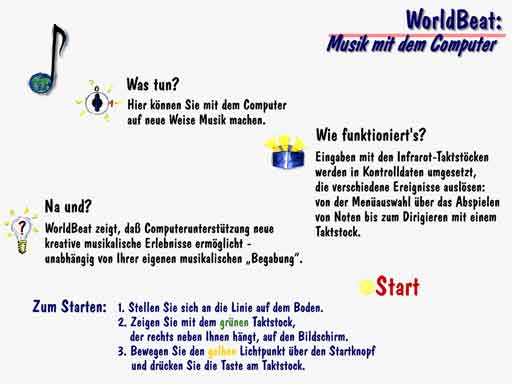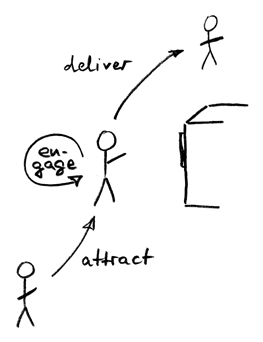| back to index | |||
H1 Attract-Engage-Deliver * |
|||
 Visitors in the Ars Electronica Center |
|||
| The prerequisites for interaction design, such as initial
user profiling and task analysis, are fulfilled, and you are
now starting to design the overall user experience of your
interactive exhibit. You want to decide what the goal of the
interaction is, and what interaction phases can be distinguished
to achieve that goal.
|
|||
|
* * *
|
|||
| An interactive exhibit is mostly used by people for entertainment,
but it usually has to fulfil a purpose beyond
that. However, the intended usage duration is generally
limited because many visitors should be able to experience
the exhibit over the course of a day.
|
|||
|
The user profile of an interactive exhibit is usually very broad, and users generally have no strong need to use such a system. This means that the initial interest to use such a system must be motivated by the system itself. |
|||
| Delivering a message |
Most interactive exhibits are not just for entertainment. Their goal is deliver a "message" - to explain some facts, concepts, or ideas - to the user, through the interaction. Therefore, it is important, after the initial attraction, to keep the user occupied until this message can be delivered. But once this goal has been achieved, it is important to allow the user to end the session in a planned and positive way. Users generally should not break off in the middle of an interaction because they have become bored, or because they do not know when they will be able to leave the system orderly. |
||
| Exploratorium |
For example, in the Exploratorium, a children's technology discoverymuseum in San Francisco, each exhibit is labelled with a three-sentence description of the following form: To do and notice: This part explains briefly what to do with the exhibit, which buttons to push or levers to move, and what to look for in the system reaction. For example, an exhibit on glass fibres would tell the user to press a button to light a lamp, and to observe how the light comes out of the end of a bent glass fibre. What's going on?: The second sentence summarizes what is happening in the system. In the example, it would explain how the light is reflected by the inside of the glass fibre wall. So What?: The last sentence, probably most important, tells the visitor why this phenomenon is important. In the example, it would explain how glass fibre cables can be used to transmit information very quickly. These descriptions actually make the attraction, engaging, and delivering phases of the interaction with an exhibit explicit. | ||
| WorldBeat: Explore feature |
Similarly, the WorldBeat system wants to convey an overall message: that computers open up new ways to interact with music. Each of the various sub-functions of the system shows a more specific example of this general message: how computers can help with conducting, improvising, finding music, etc. The system initially attracts visitors with an interesting yet simple interface that quickly leads to a main selection display of those features. Each feature in turn briefly and explicitly explains what its "message" is. When the user has explored one of those features, he has taken its specific message with him, and is returned to the main selection page where he can continue exploring the system, or leave the exhibit in a consistent and satisfying way. Nobody explores the system completely; this would also take much longer than the interaction duration as planned by the exhibition centre. Instead, most users explore only a few of the features, but still take the messages from those features with them.  Figure: The WorldBeat start screen, explaining what to do, how the system works, and what its main message is. |
||
|
Therefore: Design the interaction so that it takes place in three phases: attracting users, engaging them, and delivering one of the "messages" to them which the system wants to convey. Attach an average interaction time to each of those phases so that a typical, successful interaction with message delivery only lasts as long as allowed by the institution for its visitor throughput. |
|||
 |
|||
|
* * *
|
|||
|
To get people to have a closer look at your system in the first
place, attract them with the initial appearance of your system when
they are close to it - Attraction Space.
To keep them engaged, gradually reveal more interesting features of your system to them - Incremental Revealing. If your system has several messages to convey, let the user know when each one is delivered, and offer an option
to leave the system - Closed Loop.
|
|||
This pattern is taken from the book "A Pattern Approach to Interaction Design" (PAID) by Jan Borchers (John Wiley and Sons, Chichester, UK, 2001). Copyright 2001 John Wiley and Sons. Used by permission. See http://media.informatik.rwth-aachen.de/paid.html for more information. Online version by Susan Babutzka, ETH Zurich (subabutz_at_student.ethz.ch). |
|||